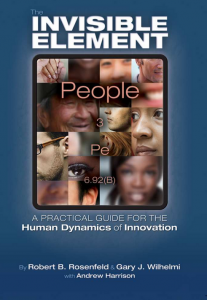
The Invisible Element: A Practical Guide for the Human Dynamics of Innovation by Robert B. Rosenfeld, Gary J. Wilhelmi, and Andrew Harrison. !nnovatus Press, 2011. 250 + xxi pages and appendices. US$21.95.
The Invisible Element is an interesting book for chemical engineers interested in building better problem-solving teams. Part One, The Eight Human Principles, introduces the reader to core values, mindsets, and behaviors of individuals working in innovation, as all engineers do. Part Two, Putting the Principles into Action, pulls these ideas into a cogent picture for organizational change.
Chemical engineers are faced with daily opportunities to innovate and solve problems with our special creative abilities. Yet, many organizations force creative restrictions through risk intolerance. One of the key themes of "The Invisible Element" is trust - at both the individual and organizational levels. The authors argue that trust and creative risk-taking are intimately tied to one another.
In particular, Chapter 2, Trust is Foundational, defines the two types of trust required for innovation success: intellectual trust and emotional trust. Engineers demonstrate intellectual trust when we respect the professional opinion of a fellow engineer and value his or her design judgment. "Heart trust," or emotional trust, describes faith in another person that he or she will not let you down - think of your significant other or best friend. When individuals have a high degree of intellectual trust, absent emotional trust, the organization can be successful in getting jobs and tasks done efficiently. Yet, the fear of failure leads to only "ho-hum" problem-solving with high risk avoidance.
As emotional trust increases between peers, and throughout the organization (Chapter 13), subject matter experts can pursue revolutionary ideas independently with little fear of repercussion. Trust allows leaders to fully leverage diversity of thought and experience (Chapter 5) and for creative problem-solvers to follow their passions (Chapter 7).
Trust materializes in behaviors while culture (shared values and assumptions) is found by observing behaviors. The four cultures model (pg. 121) delineates organizational culture based upon dimensions of sociability (heart trust) and solidarity (getting the job done).
Communication, decision-making, and knowledge transfer, rewards/recognition, and quantifiable gain round out Part Two of The Invisible Element. Chapters dedicated to these topics offer templates and worksheets to help managers and leaders determine the current state of their organization and identify gaps with the desired future state.
To create an innovative problem-solving culture, team members, supervisors, and leaders must understand the human principles and organizational change. The Invisible Element can help leaders take stock of their employees, co-workers, and company culture to yield more creative problem-solving. I recommend The Invisible Element to any engineer or professional wanting to learn more about the human nature of innovation and problem-solving.


